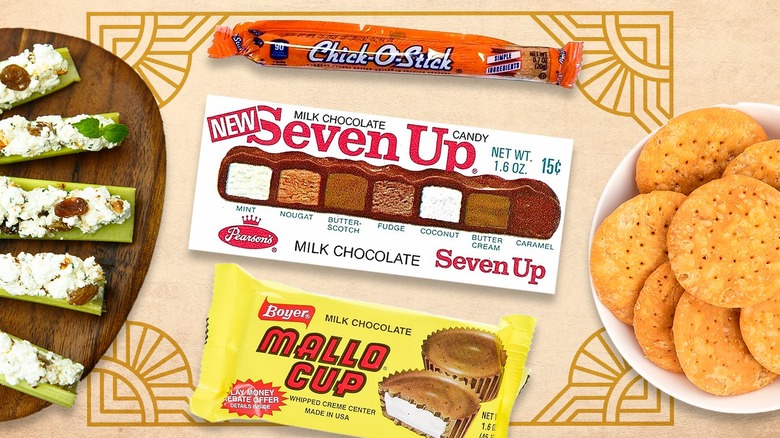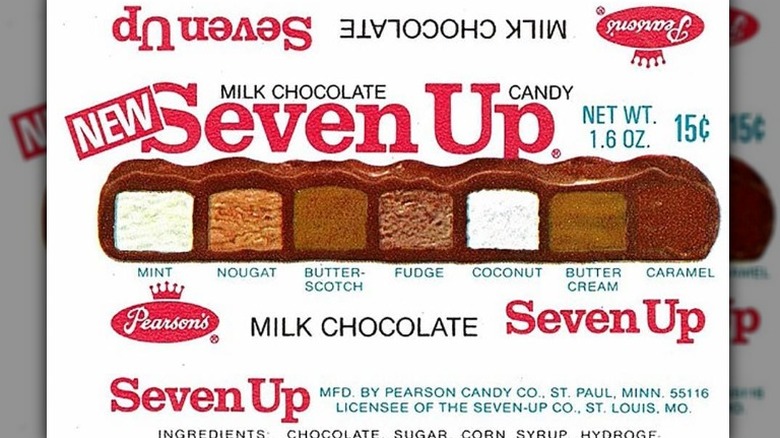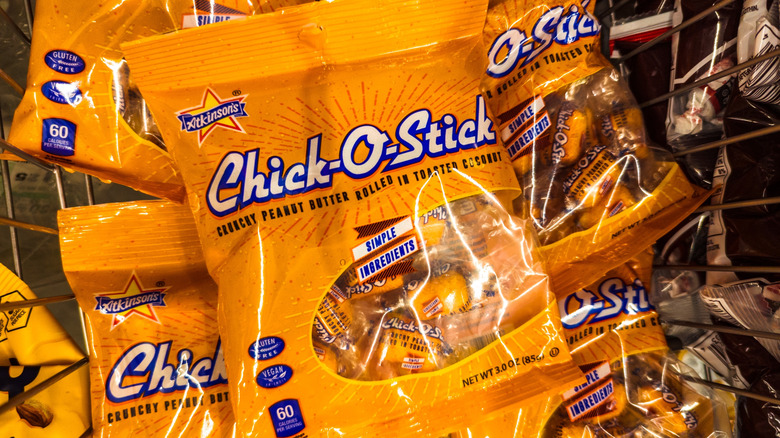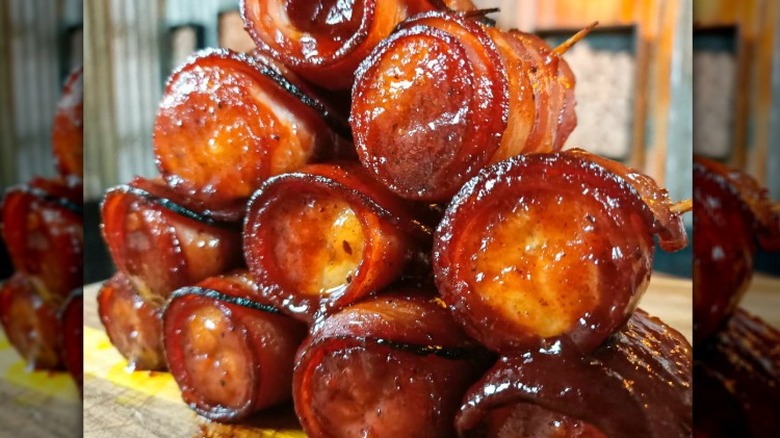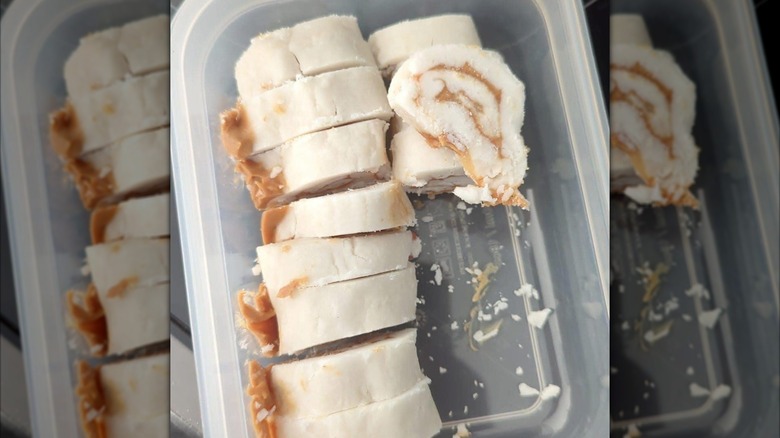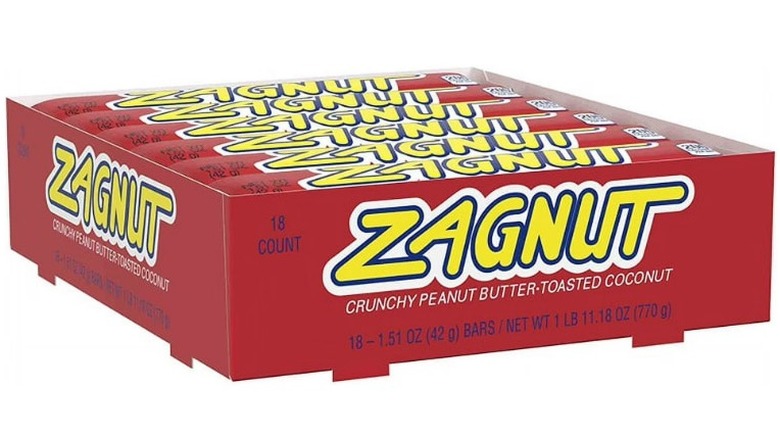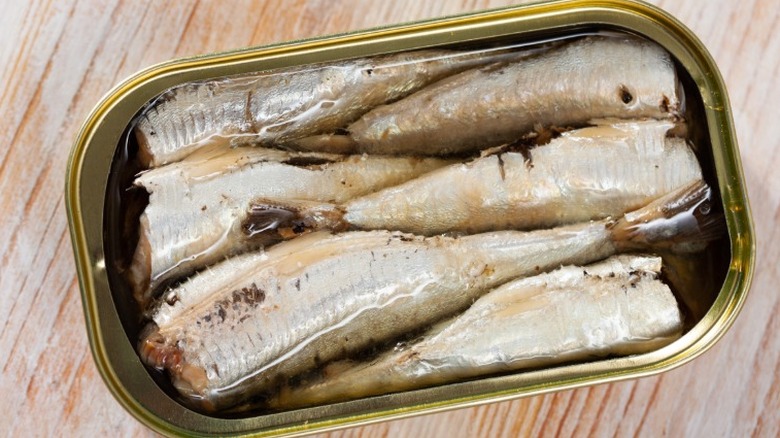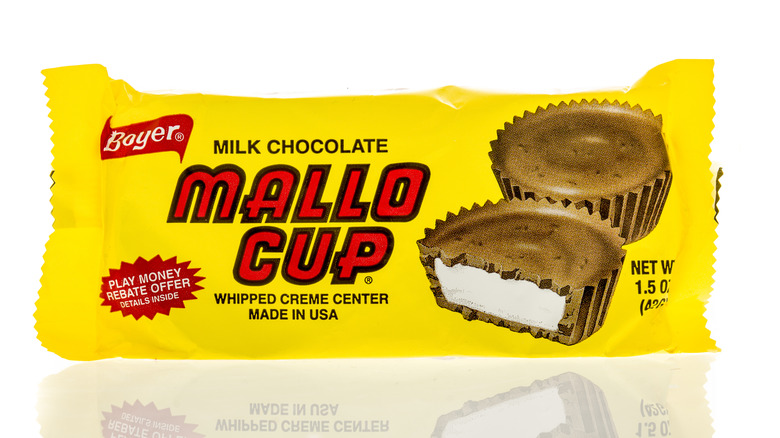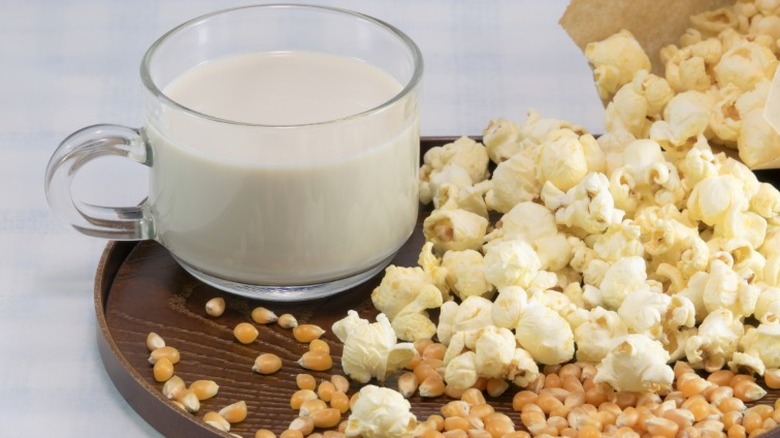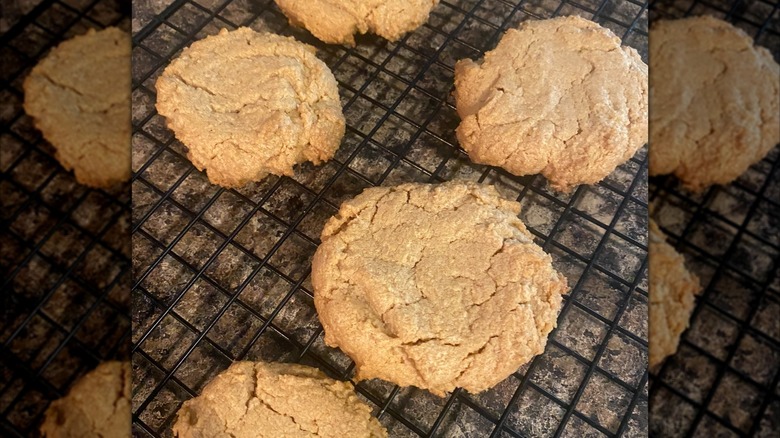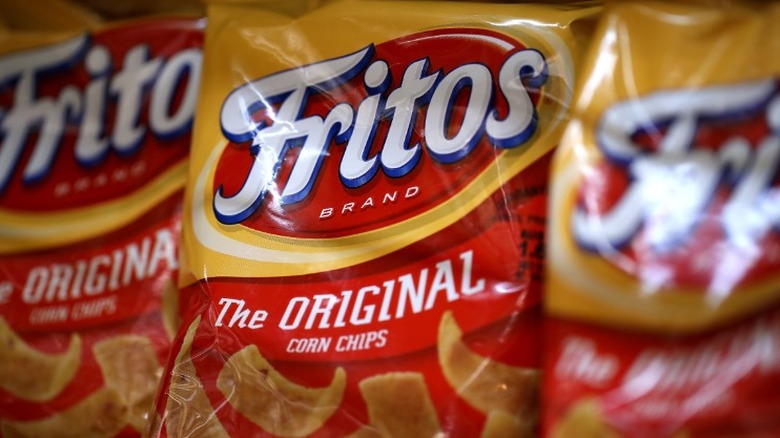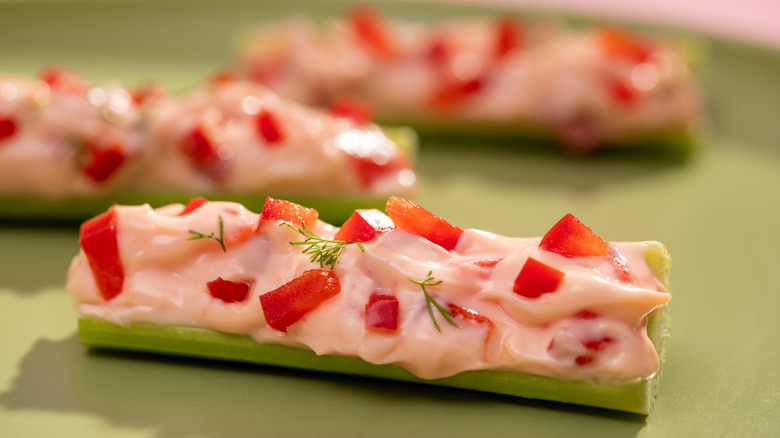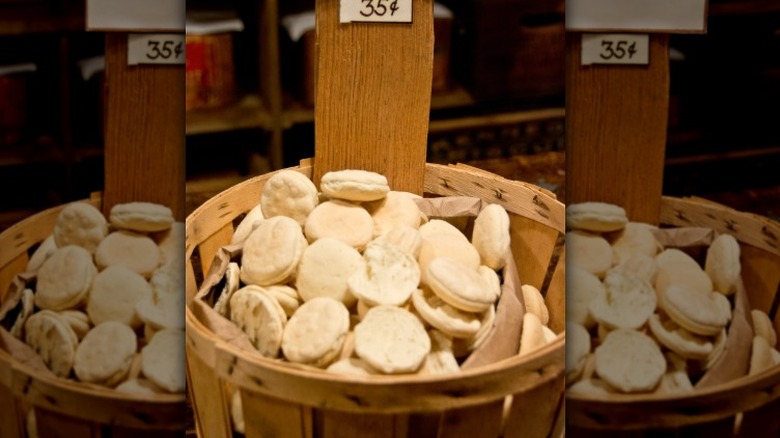12 Vintage Snacks People Loved To Eat In The 1930s
The economic devastation that followed the 1929 stock market crash meant that, for many families, the simple act of putting food on the table would be a major hurdle moving forward. During the Great Depression, people across the country were left without jobs. Though the demand for food was high, many struggled to afford it. This ushered in a time of innovation when families cobbled together what cheap ingredients they had access to and created new recipes that would hopefully satisfy them.
Given the scarcity of food in the 1930s, you might expect snacking to have been the last thing on people's minds and budgets. However, many snacks actually got their start during this era. A small candy bar could act as a morale booster, a simple luxury during a time when spirits were low. Some candy companies even marketed their products as meal replacements. For those without a sweet tooth, savory foods found in stores or concocted using affordable pantry staples offered a more filling option. Some of these treats stood the test of time, while others faded into obscurity. Regardless of their staying power, these vintage snacks found their place in homes when people needed them most.
Seven Up Bars
Life is like a box of chocolates, or in this case, one chocolate bar is. The Seven Up bar was a snack created in the 1930s by Trudeau Candy. Although it's unlike anything seen today, the Sky Bar may come close, a chocolate bar with four differently flavored sections. A Seven Up bar, however, crammed in a whopping seven different flavors. Under Trudeau, the chocolate included fillings such as Brazil nut caramel, apple butter jelly, and maple walnut cream. In 1951, Pearson's Candy Company took over production, introducing new flavor chambers like coconut, nougat, and mint. But anybody lucky enough to try one of these treats would tell you it held even more surprises.
Some Seven Up enthusiasts recall the textural intrigue of an orange jelly filling, and still others remember a whole almond at the center of one of the pillows. The fillings in Seven Up bars were swapped in and out, making each rendition a new experience. The outer chocolate coating varied as well, with customers recalling dark chocolate versions. Unfortunately, it was discontinued in 1979, making it one of many old-school candy bars that deserve a comeback. Though the reasons aren't completely clear, brand conflicts with the well-known soda, 7Up, probably played a part. And the labor that likely went into making this goliath of a candy bar can't be understated either.
Chick-O-Stick
Candies named after chicken are surprisingly common. The Chicken Dinner candy bar of the 1920s was one of the most notable examples until Chick-O-Stick came along. When Chick-O-Stick was introduced in the late 1930s, it was originally known as Chicken Bones. Atkinson Candy Company made the switch to the less poultry-adjacent name in 1955. Luckily, at no point in history did Chick-O-Stick actually taste like chicken. Instead, each cylindrical candy piece blends salty and sweet with a peanut buttery center and toasted coconut coating. Fans of the candy have compared its texture and flavor to the inside of a Butterfinger.
Chick-O-Sticks are still available to the public from the same company that made them all the way back in the '30s. Today, the snack not only comes in the classic stick shape but also in Chick-O-Stick bars and nuggets. Another fun tidbit: Chick-O-Sticks are actually on the healthier end of the candy spectrum. Not only are they accidentally vegan, but the ingredients don't include artificial flavorings or preservatives. That makes tasting this piece of history a little more intriguing.
Bananas wrapped in bacon
The Depression era was all around a time of strange food combinations. With dishes like peanut-butter-stuffed onions and water pies floating around, bacon-wrapped bananas sound fairly tame in comparison. In fact, this vintage snack reflects how our love for salty and sweet combinations has stood the test of time. Elvis Presley's peanut butter, banana, and bacon sandwich is still hailed as one of the greatest celebrity recipes for a reason. It just works.
Bacon-wrapped bananas are simple. Cut the bananas into pieces, however big or small, and wrap them with bacon strips. Cook them until the meat layer has crisped up and they're ready to eat. This recipe's simplicity probably influenced its popularity, but there's a little more to the story. Starting in the early 1900s, the United Fruit Company was on a mission to market bananas, which were newly introduced in the U.S. One notable promotional material was the 1931 pamphlet "The New Banana." It included stories of all the fruit's wonderful health benefits, and the back cover featured a picture of bananas wrapped in bacon. The pamphlet advertised bananas and bacon as a sort of talking point for dinner parties that no doubt got guests talking.
Potato candy
The potato was a mainstay of the 1930s. It was an affordable staple and versatile enough to be turned into anything from pancakes and soup to candy. That's right, potato candy was a popular, homemade sweet treat for many. It uses only simple ingredients: potatos, powdered sugar, and peanut butter for the filling. Some recipes called for the potatoes to be peeled and boiled, then mashed and mixed with powdered sugar to form a dough. The dough was rolled out, spread with peanut butter, rolled back up, and cut into circular slices. Modern recipes often add milk and vanilla, but the original was simplicity at its finest.
Contrary to its name, those who have tried the candy, either in their childhood or through modern recreations, say the snack has no distinct potato flavor. The powdered sugar lends the treat a strong sweetness, and some liken it to peanut butter fudge. For a candy made with only three ingredients, you really can't go wrong. Though it was born out of scarcity, this is one vintage potato dish that deserves a comeback.
Zagnut Bars
The Zagnut Bar is strikingly similar to the Chick-O-Stick. Both are crunchy peanut butter candies coated in coconut. Zagnuts originated in 1930 and were later acquired by The Hershey Company in 1996, and they're still sold today. Despite the similarities to Chick-O-Sticks, many people who have had both seem to prefer the Zagnut bar. Some say the Chick-O-Stick is too sugary and hard, while Zagnuts have a more complex flavor.
Zagnuts were not only popular with civilians in the past, but also among soldiers. The long shelf lives of mass-produced candies made them a popular choice to weather the Great Depression and the even harsher conditions of war. The snack ended up making its way into World War II rations as a means of sustenance for soldiers. The peanut butter filling provided a little protein, and since there was no chocolate coating on the outside, melting wasn't an issue. Nowadays, protein bars may have taken Zagnuts' place as quick meal replacements, but the candy is still out there for all your sweet-tooth-fueled needs.
Sardines
Tinned sardines are an affordable seafood that also tastes delicious. Today, sardines and other tinned fish have become a trend on social media, with people posting reviews and hosting full-on tinned fish parties. There are even subscription boxes dedicated to sharing tightly packed seafood from around the world. Sardines weren't always considered a viral snack, however. During the Great Depression, they became a staple because they were an affordable and long-lasting source of nutrition.
In fact, they were so popular that Monterey, California, known as the "Sardine Capital of the World," was able to circumvent some of the Depression's impact due to the growing demand for the tinned fish. They were eaten straight from the can as a snack or sometimes a meal. To make the fish a little more interesting, they were also used alongside other ingredients. One recipe involved wrapping sardines in pastry, kind of like a fishy spin on pigs in a blanket.
Mallo Cups
The Reese's Peanut Butter Cup is one of the most popular candies in the U.S. and is known for its distinctive short and round shape. However, despite its immense success, it was not actually the first of its kind. The title of the first candy cup goes instead to Mallo Cups, made by Boyer Candy Company. These pioneering snacks are one of the most underrated candies, boasting a whipped, marshmallowy center with bits of coconut, all surrounded by a layer of milk chocolate. There is a dark chocolate version available now as well. Boyer Candy is still churning these out today, along with some of the same nostalgic perks the treat had in the past.
Folks who grew up with Mallo Cups will remember the cardboard coins found inside the wrappers, which could be collected and redeemed for more of the chocolates. Nowadays, you can still find this play money when you buy a Mallo Cup. Depending on how much you collect, you can get anything from a magnet or T-shirt to, of course, more candy.
Popcorn (with milk)
Movies and popcorn go hand in hand. Across the world, popcorn is a staple concession in movie theaters, but did you know that it wasn't always this way? The Great Depression actually skyrocketed the popularity of the snack inside and outside of the cinema. Popcorn was cheap to make and affordable for most buyers, leading vendors to sell it on the streets outside theaters. Eventually, the cinema companies began to take advantage of the salty treat's growing popularity.
You might recognize the name Jolly Time. This popular brand of popcorn began in 1914 but experienced a major boom in the '30s. The company had a radio show that it used to promote the brand and sell one-dollar popcorn machines. Customers could also buy Jolly Time popcorn from vendors for only a dime. The snack represented an affordable luxury for many and could even be used to feed families on a budget. In fact, popcorn was one of many vintage breakfast foods no one really eats anymore. Some people would even pour milk over popcorn and eat it like cereal. The milk added some protein and vitamins, turning a simple snack into a more filling meal.
Poor man's cookies
As their name suggests, poor man's cookies are an innovative dessert recipe born out of the desire for sweet treats paired with a lack of access to traditional ingredients. Most standard cookie recipes contain eggs and butter. After all, they add moisture, structure, and flavor to the treat, so how could you leave them out? There are plenty of vegan recipes that do just that, but even before the modern popularity of vegan recipes, there was another reason to forgo eggs and dairy. These products became a luxury during the Great Depression, as the average person couldn't afford them. To replace these ingredients, people instead turned to the more affordable, shelf-stable items they did have.
A standard recipe for poor man's cookies requires shortening, flour, sugar, baking soda, rolled oats, salt, vanilla, and water. The mixture comes together and gets baked much like any other modern cookie recipe. And though the recipe is simplistic, the results hold up to the test of time. The final cookie is similar to a classic oatmeal cookie, with a subtle but warming flavor and a satisfying chew. Not only are they affordable, but the sparse ingredient list also means they're suitable for vegans. If you do want to spice them up a little, you can always add some cinnamon or nutmeg to the mix or pair the baked cookies with a scoop of ice cream for a more luxurious take.
Fritos
The renowned Frito pie is one of those Texas foods everyone must try at least once. The combination of salty corn chips with warm chili and cheese is so good that people often argue over who invented the dish first. What's really interesting, however, is the origin of the classic chip that forms the basis of this winning combo. Fritos date back to around 1932, when an American named Charles Elmer Doolin bought the recipe from a Mexican named Gustavo Olguin, who was making the corn chips from masa. Doolin also purchased a potato ricer, which he used to start making Fritos himself. For Doolin and his family, this simple chip was an economic opportunity. Eventually, his business expanded into the Fritos brand still loved to this day.
Fritos were a popular snack all on their own, but they were also paired with other foods throughout the '30s. A look at old articles and menus reveals that people served the chips alongside chili, tamales, and beans. These combinations made sense with the chip's origins in Mexican cuisine and remain popular pairings today. Though the beloved Frito pie didn't come about until 1946, the foundations were clearly being laid early on.
Stuffed celery
Celery isn't the most exciting of snacks, but it was commonly eaten throughout the Great Depression. It could be consumed alone or used in many filling recipes, such as celery soup and ham and celery loaf. Stuffed celery, in particular, was a popular snack. The vegetable served as a nutritious vessel for any number of extras. One unusual version of the snack suggested in a 1935 newspaper was celery stuffed with crabmeat sticks.
One of the more interesting and widespread takes on this snack was olive-stuffed celery. For the well-to-do individuals of the time, this was also an old-school appetizer that almost everyone has forgotten by now. The vegetable was a simple snack, but it could be a sign of luxury if used correctly. In fact, many cookbooks and advertisements from the 1930s included celery and boasted its appeal. To prepare the olive-stuffed celery, the hollow centers of the stalks were filled with cream cheese and olives. The result was a quick bite to whet dinner guests' appetites. Celery and olives were a common pairing, no matter their form. Several menus from the '30s mention olives and celery –– especially as appetizers –– and the two foods were staples at Thanksgiving tables across the country.
Common crackers
If you're from the New England area, especially the state of Vermont, you've probably heard of or tasted common crackers at some point. This snack goes by a few different names. Not to be confused with the small, crunchy oyster crackers, common crackers are also called Cross crackers or Montpelier crackers. They are larger in size with small holes on their surface and a crisp, puffed texture. Don't be fooled by their plain appearance; they are a well-loved snack. The simplistic nature of these bites, however, should give you some clue as to their origins.
Although accounts vary, research indicates that these crackers have been around since the early 1800s, though the exact inventor is unsettled. What is known is that they were common in the early 1900s and were first mentioned in print in 1939. The popularity of the common cracker stemmed from the fact that it was a thick cracker with a long shelf life and could be used for many different purposes. Of course, they made a fine snack by themselves. But they could also be used as budget-friendly replacements for more expensive ingredients.
For example, these crackers could be crushed up and used for pie fillings. They also made a good alternative to bread in bread pudding dupes. Today, the Vermont Common Crackers brand sells tins of crackers made using the original recipe. Have them with a bowl of clam chowder, per Julia Child's recommendation, and you'll be good to go.
